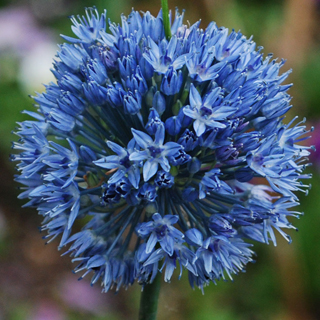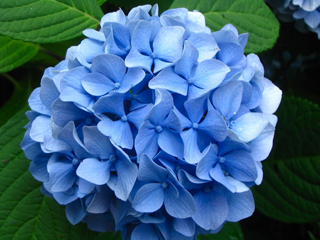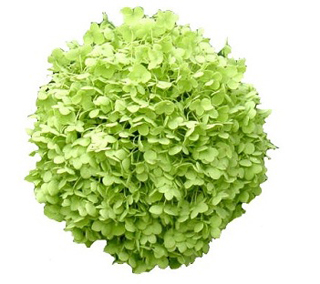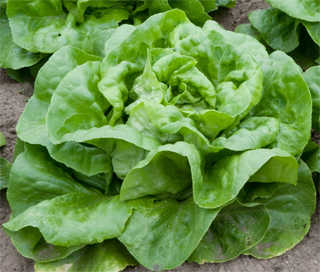 I have had the most fabulous display of alliums in the garden for weeks. There are so many different varieties that it is possible to have allium bulgaricum from mid-May through to mid-June. Early June brings on allium giganteum, christopherii and many others, actually in excess of 500 species. So I have been enjoying the big round purple and white heads followed by the daintiest and only blue one, allium caerullium which has a small head but doubles or trebles its bulbs every year to give the most fantastic display.
I have had the most fabulous display of alliums in the garden for weeks. There are so many different varieties that it is possible to have allium bulgaricum from mid-May through to mid-June. Early June brings on allium giganteum, christopherii and many others, actually in excess of 500 species. So I have been enjoying the big round purple and white heads followed by the daintiest and only blue one, allium caerullium which has a small head but doubles or trebles its bulbs every year to give the most fantastic display.
Pink allium are also available but don’t match my colour scheme in the border. It’s a simple border plan. Purple and white allium with low growing purple campanula followed by an orange geum coccineum and giant blue and white agapanthus all edged off with lavender Vera, a big blowsy girl which, in my opinion, puts cute and tidy little Munsteads to shame.
 The most common problem with alliums is that many lose their lower leaves quickly and what is left is tatty. I therefore plant them amongst the agapanthus which have similar leaves and cover up the bare bottoms, so to speak. You also have to watch for snails that will climb up the stems, munching the green outer stem and then hiding in the head at the top. Just being vigilant stops this problem and is well worth the effort.
The most common problem with alliums is that many lose their lower leaves quickly and what is left is tatty. I therefore plant them amongst the agapanthus which have similar leaves and cover up the bare bottoms, so to speak. You also have to watch for snails that will climb up the stems, munching the green outer stem and then hiding in the head at the top. Just being vigilant stops this problem and is well worth the effort.
If you have never grown alliums give them a go. All you need is to buy bulbs in the autumn and plant in a dry sunny border and they are there forever multiplying all the time. If you are a flower arranger they are superb, one of my favourites a droopy allium bulgaricum will last three weeks in a vase and a tiny drop of bleach in the water takes away any onion smell.
 Now summer I think really has arrived? The hydrangeas are a little later than usual like many plants, the white ones flowering first and then all the others this month smothered in flower heads and probably the best display I have ever had. Just like the alliums there are too many varieties to choose from and none that I don’t like.
Now summer I think really has arrived? The hydrangeas are a little later than usual like many plants, the white ones flowering first and then all the others this month smothered in flower heads and probably the best display I have ever had. Just like the alliums there are too many varieties to choose from and none that I don’t like.
They are not everybody’s favourite because they are so common but the breeders have given us some fantastic varieties and if you are worried about whether they will be blue or pink or purple then go for a white or green variety that never changes colour. But a north facing fence covered in a H. petiolaris is a sight to behold. I have a hit and miss north facing fence and my neighbours are having as much pleasure from the hydrangea as I am on my side.
 Its wound its way through the fencing to burst out into their garden and neither of us are complaining! Some of the most beautiful hydrangeas are green (limelight starts white and goes green, double value!) and don’t change their colour on an alkaline or acid soil. There many varieties an all shapes and sizes, mopheads, evergreens, lace caps and conical. Not forgetting the oak leaf and aborescens and variegated leaves. What a versatile family. One of the best ways to choose any plant is to put ‘images’ into your search engine. Find the photograph of theone you like and find its name that way.
Its wound its way through the fencing to burst out into their garden and neither of us are complaining! Some of the most beautiful hydrangeas are green (limelight starts white and goes green, double value!) and don’t change their colour on an alkaline or acid soil. There many varieties an all shapes and sizes, mopheads, evergreens, lace caps and conical. Not forgetting the oak leaf and aborescens and variegated leaves. What a versatile family. One of the best ways to choose any plant is to put ‘images’ into your search engine. Find the photograph of theone you like and find its name that way.
The cool weather in June has delayed my strawberries and a fabulous crop of asparagus (eventually) and the sweet corn is so glad to see the sunshine. The runner beans are racing up the poles and I have planted three varieties this year for different coloured flowers, white, red and pink. The onions are looking ok, I am not sure yet if we will have any prize winners but I have had another go at red onions to adorn the summer salads if not the exhibition bench and also Kelsey, the big one that show winners exhibit. Mine are not nurtured and so will not be huge exhibits but it’s a strong grower and seems to resist all the problems onions can have, particularly neck rot.
 In the veg garden you are probably harvesting like mad. But spare a thought for the autumn veg and plan for it now. As soon as a bit of ground becomes available re-vitalise it with some compost and plant a follow on crop. Lettuces are welcome throughout the autumn and can be sown now as long as they get enough moisture. Germinate the seed outside either in the ground or in modules. Lettuce seed will not germinate in hot conditions so avoid the greenhouse for this purpose.
In the veg garden you are probably harvesting like mad. But spare a thought for the autumn veg and plan for it now. As soon as a bit of ground becomes available re-vitalise it with some compost and plant a follow on crop. Lettuces are welcome throughout the autumn and can be sown now as long as they get enough moisture. Germinate the seed outside either in the ground or in modules. Lettuce seed will not germinate in hot conditions so avoid the greenhouse for this purpose.
Beetroot sown now will produce baby beets for autumn and for the Show. Rapid germination can be achieved by washing the seed capsules in a flour sieve under the tap to remover any inhibitor that has been applied by the seed merchant. Because the soil is warm, carrot seed will germinate quickly now and produce young roots this season for instant use or for storing. Turnips can be sown too or even left until later this month or next. They are quick to mature and will withstand an early frost if necessary. Swiss chard and spinach beet will also withstand cold weather.
 July is a good time to rejuvenate herbs. Sorrel will have run to seed but cut down now it will produce fantastic young shoots. Marjoram, mint and tarragon respond to a good haircut too. Once cut, sprinkle a general purpose fertiliser and give them a good watering to encourage rapid growth. The new leaves are much tastier than the tough old ones.
July is a good time to rejuvenate herbs. Sorrel will have run to seed but cut down now it will produce fantastic young shoots. Marjoram, mint and tarragon respond to a good haircut too. Once cut, sprinkle a general purpose fertiliser and give them a good watering to encourage rapid growth. The new leaves are much tastier than the tough old ones.
Look out for blight on the potatoes, once you’ve seen it it’s too late but may be an indicator that your tomatoes may also succumb. Keep an eye out for red spider mite on cucumbers and if it’s really hot you may need to shade greenhouses with that ghastly white paint like stuff. Remember that cucumbers need more humidity than tomatoes and if allowed to dry out will invite the spider mite.
 July is a grand month for harvesting, living on broad beans and strawberries and looking forward to the runner beans and corn. I also think it’s a good time to take time to look at what is doing well in the flower borders. When the plants are up and flowering it is much easier to see which need lifting and dividing in the autumn because they are just too large.
July is a grand month for harvesting, living on broad beans and strawberries and looking forward to the runner beans and corn. I also think it’s a good time to take time to look at what is doing well in the flower borders. When the plants are up and flowering it is much easier to see which need lifting and dividing in the autumn because they are just too large.
Writing yourself a note for later in the year or just putting a tag around the stem will remind you what you need to do later. And don’t be too hasty. I dug up and removed a row of salvias that were just too big last autumn. They were replanted where they had more space and clearly were not happy. This year there has been no growth and I assumed I had killed them. In June I started digging them up only to find shoots at the base below soil level. Only now are they just emerging and they will be welcome late flowers but my haste nearly destroyed them.
Gardening can teach you patience and the rewards reaped in these summer months are well worth that patience and hard work. If you have made mistakes or have failures put it all down to experience and remember for next year.

